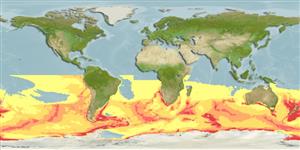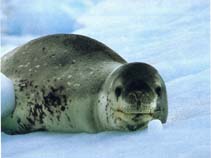Hydrurga leptonyx (de Blainville, 1820)
Leopard seal| Native range | All suitable habitat | Point map | Year 2050 |

|
| This map was computer-generated and has not yet been reviewed. |
| Hydrurga leptonyx AquaMaps Data sources: GBIF OBIS |
Classification / Names Common names | Synonyms | CoL | ITIS | WoRMS
Mammalia | Carnivora | Phocidae
Environment: milieu / climate zone / depth range / distribution range Ecology
Bathydemersal. Polar; 0°N - 90°S, 180°W - 180°E
Distribution Countries | FAO areas | Ecosystems | Occurrences | Introductions
Indo-Pacific, Atlantic Ocean, and the Antarctic.
Length at first maturity / Size / Weight / Age
Maturity: Lm ? range ? - ? cm Max length : 300 cm TL male/unsexed; (Ref. 1394); 360 cm TL (female); max. published weight: 450.0 kg (Ref. 1394); max. published weight: 450.0 kg
Found throughout the pack ice zone; haul out on ice and land, often preferring ice floes, when available. Feeds on krill, fish, squid, penguins, and young seals, and will occasionally scavenge from carcasses of whales (Ref. 1394). Found throughout the pack ice zone; haul out on ice and land, often preferring ice floes, when available. Feeds on krill, fish, squid, penguins, and young seals, and will occasionally scavenge from carcasses of whales (Ref. 1394).
Life cycle and mating behavior Maturity | Reproduction | Spawning | Eggs | Fecundity | Larvae
Main reference
References | Coordinator | Collaborators
Jefferson, T.A., S. Leatherwood and M.A. Webber. 1993. (Ref. 1394)
IUCN Red List Status (Ref. 130435)
Least Concern (LC) ; Date assessed: 20 January 2015
CITES status (Ref. 108899)
Not Evaluated
CMS (Ref. 116361)
Not Evaluated
Threat to humans
Human uses
Fisheries: commercial
FAO - Fisheries: species profile | FishSource | Sea Around Us
Tools
More information
Internet sources
BHL | BOLD Systems | CISTI | DiscoverLife | FAO(Fisheries: species profile; publication : search) | Fishipedia | GenBank (genome, nucleotide) | GloBI | Gomexsi | Google Books | Google Scholar | Google | PubMed | Tree of Life | Wikipedia (Go, Search) | Zoological Record
Estimates based on models
Preferred temperature
(Ref. 115969): -1.9 - 1.4, mean -0.5 (based on 2109 cells).
Resilience
(Ref. 69278):
High, minimum population doubling time less than 15 months (K=0.36-0.47).
Price category
(Ref. 80766):
Unknown.



